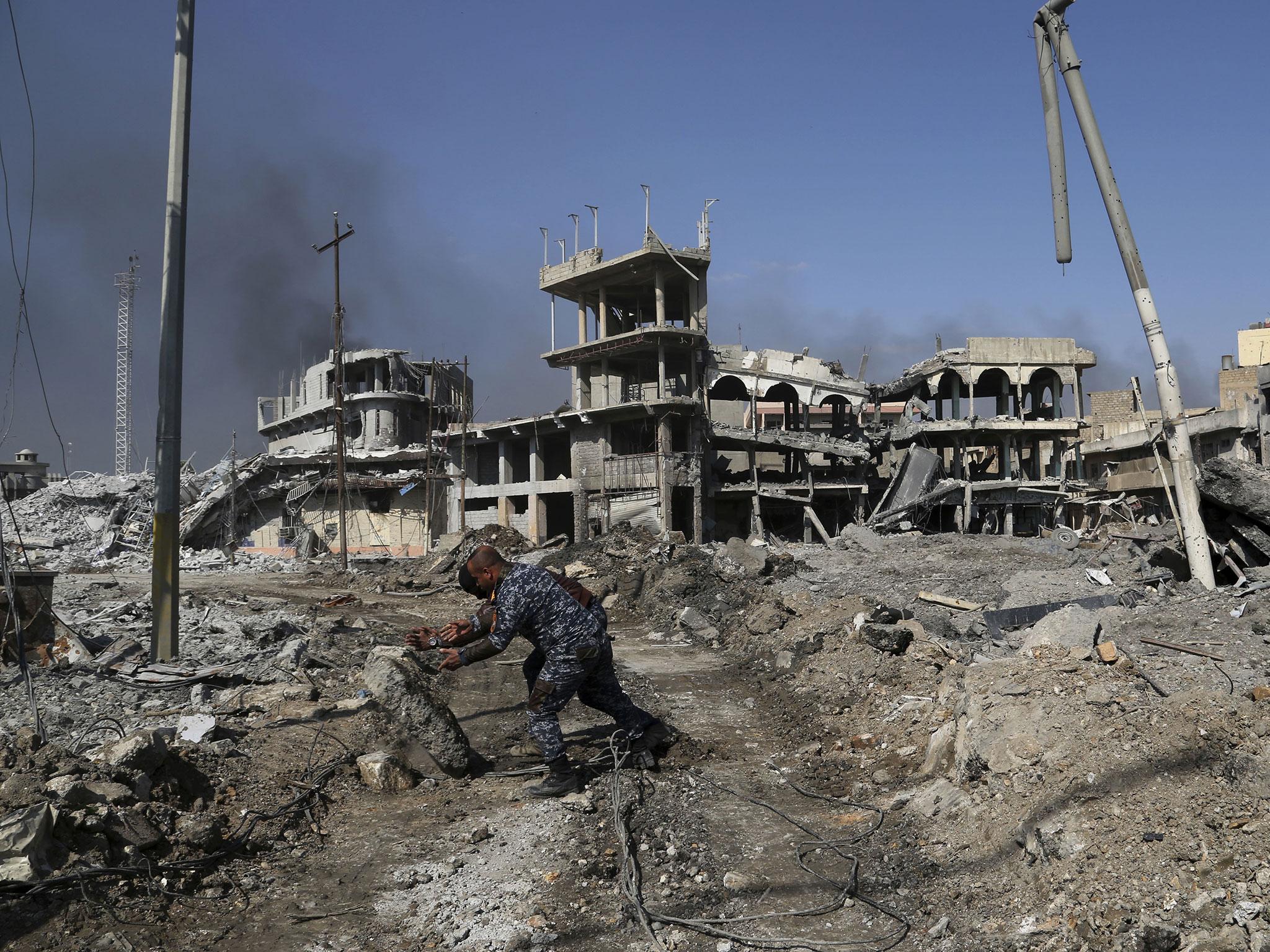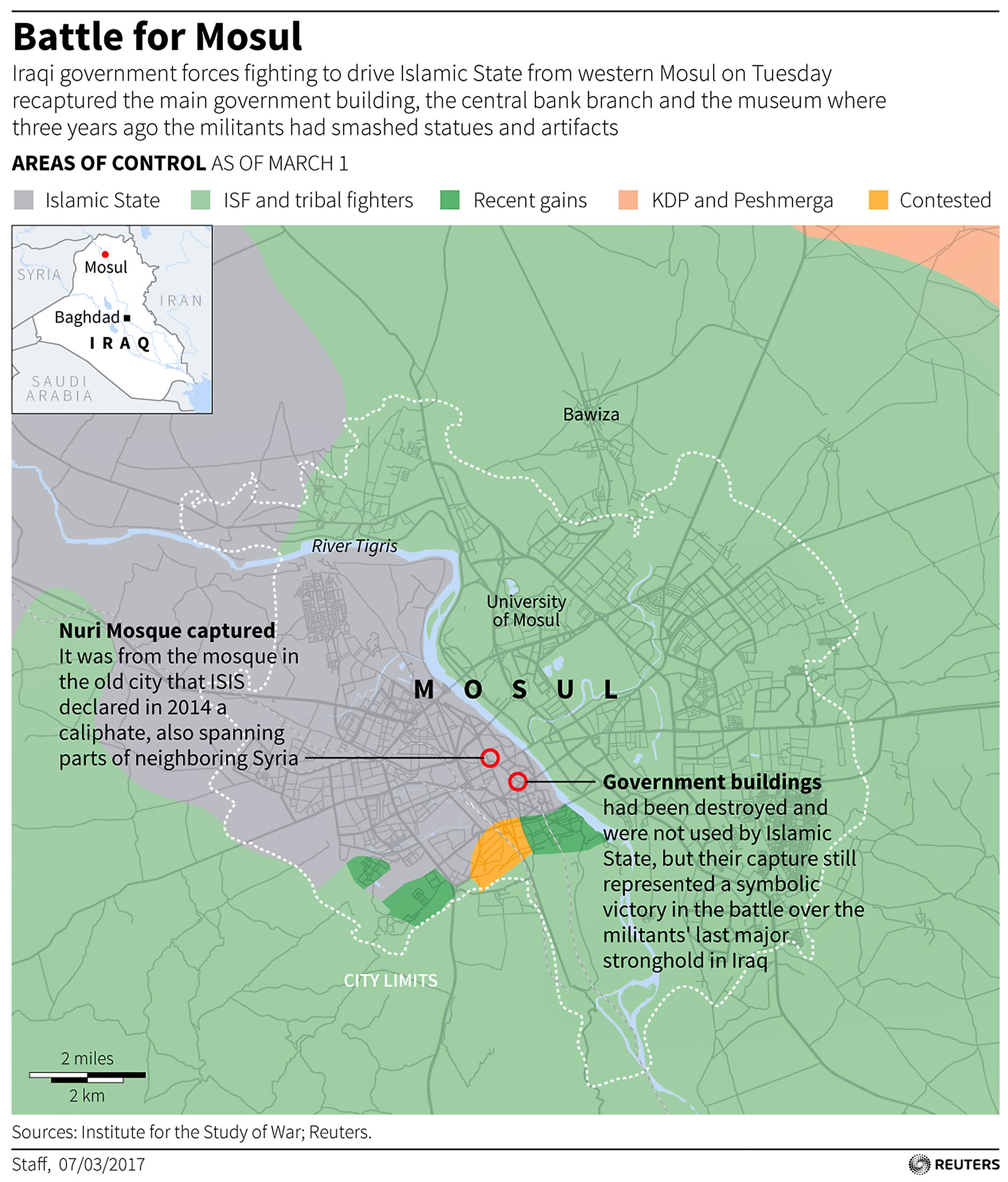Iraqi army recaptures key government buildings from Isis in Mosul
Their capture represents a symbolic victory in fight to oust Isis from last Iraqi stronghold

Iraqi government forces fighting to drive Isis from western Mosul have recaptured the city’s main government complex, central bank branch and the museum where three years ago the militants smashed statues and artefacts.
An elite rapid response team stormed the Nineveh governorate building and government complex in an overnight raid, spokesman Lieutenant Colonel Abdel Amir al-Mohammadawi said.
They also seized a building that housed Isis’s main court of justice, known for its harsh sentences, including stonings, throwing people off building roofs and chopping off hands, reflecting the group’s extreme ideology.

“They killed tens from Daesh,” Lieutenant Colonel Mohammadawi said, referring to Isis by one of its Arabic acronyms. The raid lasted more than an hour.
The militants looted the central bank when they took over the city in 2014 and took videos of themselves destroying statues and artefacts.
Illegal trafficking of antiquities in the territory under their control, from the sites of Palmyra in Syria to Nineveh in Iraq, was one of their main sources of income.
The breakthrough paves the way for the US-backed forces to attack the militants in the old city of Mosul, the most complicated phase in the nearly five-month campaign due to the density of the population and the narrowness of the city’s alleyways. The militants are dug in amongst civilians in the historic district.
It was from the Nuri Mosque in the old city that the group’s leader, Abu Bakr al-Baghdadi, declared in 2014 a caliphate also spanning parts of neighbouring Syria.
The old city lies on the western bank of the Tigris river that cuts Mosul in two. About 750,000 people were estimated by aid organisations to live in western Mosul when the offensive started on this side of the city on 19 February.
The Iraqi forces took the eastern half in January, after 100 days of fighting. They are backed by air and ground support from a US-led coalition.
Defeating Isis in Mosul would crush the Iraqi wing of the self-declared caliphate, which is also suffering setbacks in Syria.
US-backed Syrian Democratic Forces cut the last main road out of Raqqa, the de facto Isis capital in Syria, on Monday. Isis is also fighting off the Russian-backed Syrian army as well as Turkey and allied Syrian rebels.
The number of Isis fighters in Mosul was estimated at 6,000 at the start of the offensive on 17 October by the Iraqi military who estimate several thousand have been killed since.
Lined up against them is a 100,000-strong force of Iraqi troops, Kurdish Peshmerga fighters and Iranian-trained Shia Muslim paramilitary groups.
Some of Isis’s foreign fighers are trying to flee Mosul, US Brigadier General Matthew Isler told Reuters.
“The game is up,” Brigadier General Isler said. “They have lost this fight and what you’re seeing is a delaying action.”
Isis snipers continued to fire at the main government building after it fell into government hands, restricting the movements of the soldiers.
Rapid response sharpshooters were firing back from the building. One of them said four enemy snipers had been killed.
“The fighting is strong because most of them are foreigners and they have nowhere to go,'” said the head of a sniper unit for the rapid response team.
More than 40,000 people fled their homes in the past week, bringing the total number of displaced since the start of the offensive to more than 211,000, according to the United Nations.
Dozens more streamed out of the Mamoun district in southwestern Mosul toward US-trained counter-terrorism troops as machine gunfire rang out in the background.
US special forces were also seen walking between buildings in the same area, some of them carrying assault rifles with scopes and silencers. Helicopters attacked targets just north of their positions as thick smoke filled the sky from various explosions.
Agencies say camps to accommodate them are nearly full even though the United Nations said last month that more than 400,000 people still in western Mosul could be displaced.
Several thousand have been killed and wounded in the fighting, both civilians and military, according to aid organisations.
Reuters
Join our commenting forum
Join thought-provoking conversations, follow other Independent readers and see their replies
Comments